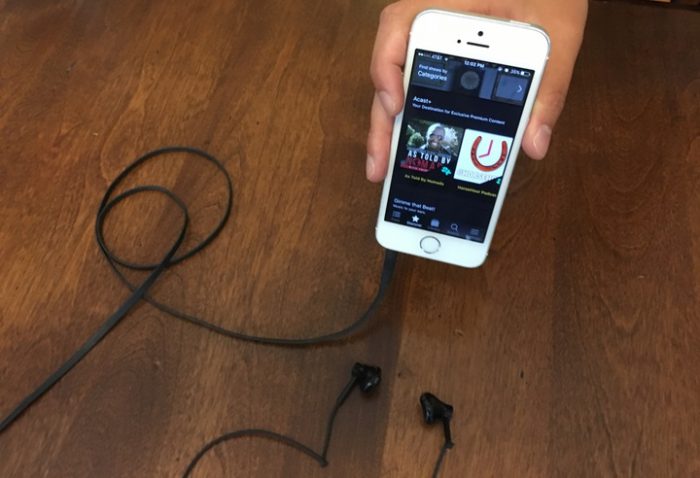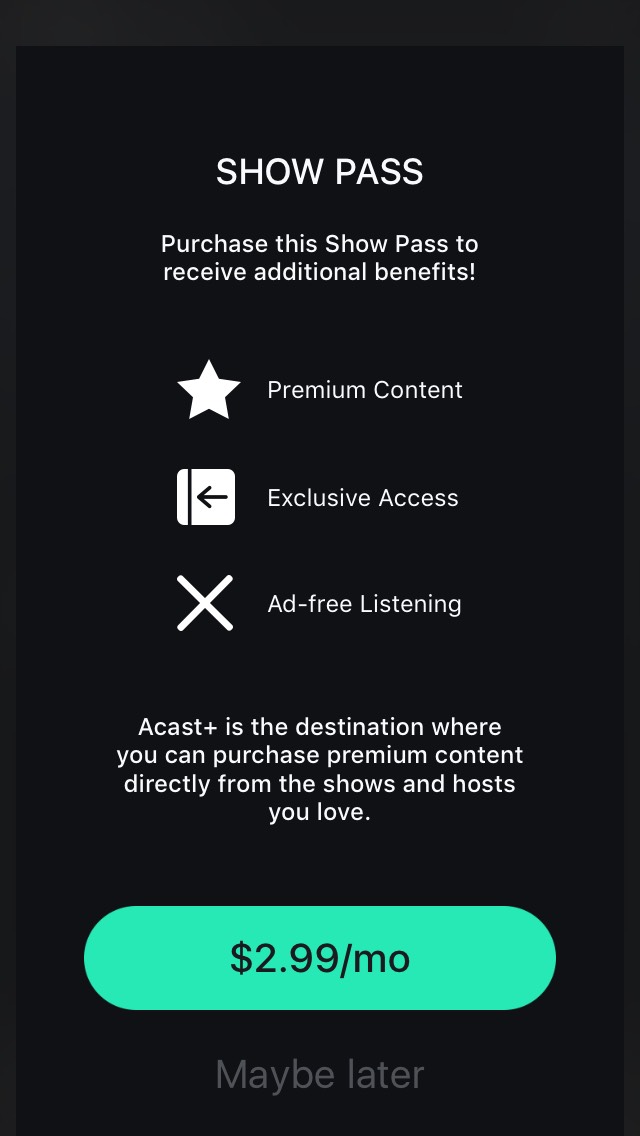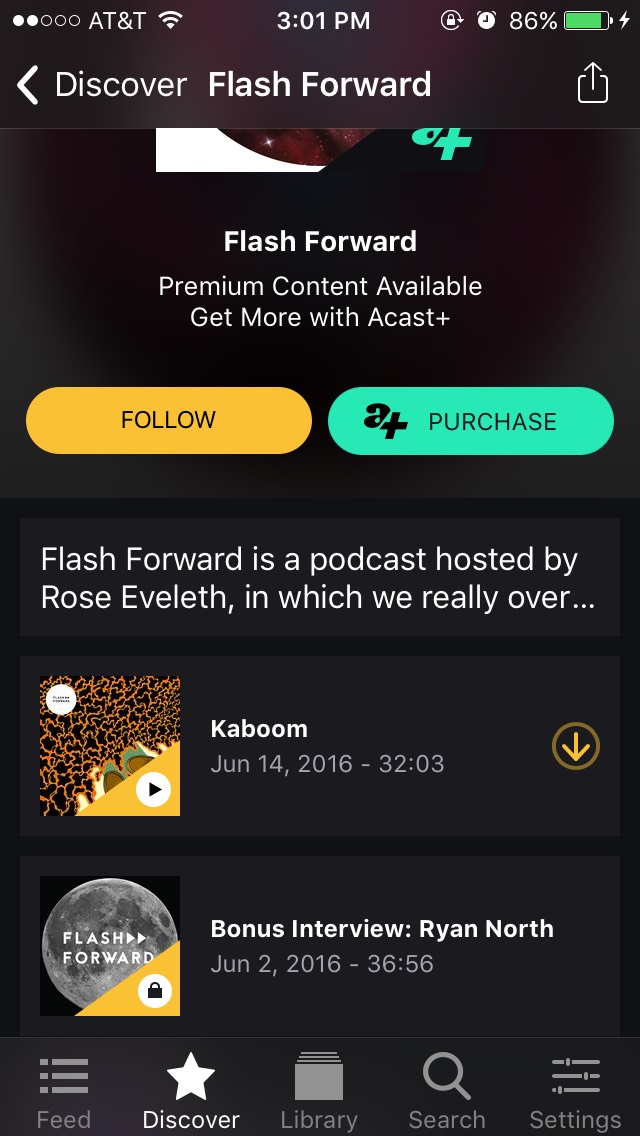
The paid option was always going to be part of the business model of the company at some point, according to the company’s founders Karl Rosander and Måns Ulvestam, but don’t call it a paywall.
“If you look at the Spotifys of the world, they started with advertising, then turned to subscriptions. If you look at the history of podcasting, you’ve got Patreon, you’ve got crowdfunding efforts. But for me that’s not a business model, that’s just begging,” Ulvestam said. “I don’t believe in a paywall system. But I believe in people paying for content they think is worth something. I mean, it’s not rocket science. If you make a good movie, if you offer a good service, if you have a book that’s good, people will pay for it.”
 With Acast+, interested listeners can purchase a “show pass” to unlock bonus shows and listen ad-free. I skimmed the Acast+ offerings and found prices ranging from $.99 to $4.99 per month, as well as other price points like $7.99 per season. The founders wouldn’t disclose the actual revenue split (“it’s good for both sides”) and said it was too early to share specific data points, but offered a few other observations. Ulvestam said, for instance, that they’d assumed the number of subscriptions would increase gradually over time, but “there was a huge sale on the first day,” followed by steadier subscription purchases. He also said that shows priced at $2 to $3 “were doing especially well.”
With Acast+, interested listeners can purchase a “show pass” to unlock bonus shows and listen ad-free. I skimmed the Acast+ offerings and found prices ranging from $.99 to $4.99 per month, as well as other price points like $7.99 per season. The founders wouldn’t disclose the actual revenue split (“it’s good for both sides”) and said it was too early to share specific data points, but offered a few other observations. Ulvestam said, for instance, that they’d assumed the number of subscriptions would increase gradually over time, but “there was a huge sale on the first day,” followed by steadier subscription purchases. He also said that shows priced at $2 to $3 “were doing especially well.”
“This is quite different from the way a music streaming service would work, because with music streaming you’re happy to pay $10 a month for all the world’s music. With podcasting, you may be able to listen to two or three or four or maybe five podcasts, but those you listen to and follow closely. You don’t have to pay for that fly fishing show you haven’t heard of,” Ulvestam added. “That’s why we don’t believe in a model like [Midroll’s] Howl, for instance — putting shows and archives behind a paywall. We don’t believe in a subscription where you access all shows without ads — we could turn that on and do that in one second, but that’s not the way our podcasters consume content, so we’re not going to do it.”
 The show Flash Forward by Rose Eveleth, for instance, is among the first shows available with bonus material through Acast+. Eveleth’s shows are available elsewhere, too (on iTunes for one), but there’s more available to fans willing to pay a little.
The show Flash Forward by Rose Eveleth, for instance, is among the first shows available with bonus material through Acast+. Eveleth’s shows are available elsewhere, too (on iTunes for one), but there’s more available to fans willing to pay a little.
This subscription model is good for accommodating material from people who have a large following for their already well-established podcast, but might want to work on a spin-off separate from their regular productions. In that case, a few thousand people paying $2 or $3 could be enough to get that project off the ground, Caitlin Thompson, Acast’s director of content, told me.
“We’ve been having a lot of conversations with creators, those who have more of a mass market audience, and getting them to think about side projects they could do if they were freed from their day jobs,” Thompson, who’s leading expansion efforts in the U.S., said. “We can find a way to fund a really special thing that doesn’t put a ton of pressure on the creator to get a huge audience. That’s an exciting thing in this marketplace.”
Thompson, who was WNYC.org’s executive editor before moving to Acast, is pushing ahead with a plan to grow Acast’s listenership outside of the iTunes set. (Another member of the Acast upper ranks, chief commercial officer Sarah van Mosel, was also poached from WNYC.)“For people who like a passive RSS subscription service, that field is pretty saturated. But a lot of people aren’t yet podcast consumers; they haven’t found that thing they like,” Thompson said. “If you look at the greater internet at large versus iTunes users — the internet is more female, browner. I’m specifically looking for content that’s going to work for somebody who might be discovering podcasts for the first time.”
Acast wouldn’t share specifics on number of users or monthly streams (a year ago, when the company had raised $5 million from Bonnier, it had a million unique users.) But Thompson cited a few other numbers, including:
— 49 percent of Acast listeners do not listen to commercial radio.
— 48 percent of Acast listeners listen to at least two hours of podcasts per day (U.S. average: 1.5 hours/day).
— 80 percent of Acast listeners listen to at least three different titles per week.
“We’re trying to fish where there’s fish, instead of competing in the iTunes universe,” Thompson said. An estimated 57 million Americans (21 percent) can be counted as monthly active podcast listeners, according to a recent report from Edison Research and Triton Digital, with the bulk of that listening probably happening through iTunes or the iOS native app. “So 80 percent of people don’t regularly listen to podcasts. We’re trying to growing that percentage of regular listening to 30 percent — 10 percent that we bring into the market — as opposed to trying to elbow our way into the ears of the 20 percent who already listen to Startup or WTF.”
Thompson highlights shows like Hard Pass and BuzzFeed’s Another Round (which Acast distributes) as shows that break with expected podcast formats and attract new audiences. Another Round is experimenting with a social audio app for voice memo calls and has a Slack channel that includes people who’ve never listened to to the show, Thompson pointed out (“Another Round has singlehandedly done more to invite new audiences into the podcast door than many others — maybe even Serial”). Hard Pass is a six-minute “lunchtime snack” of news updates, designed to be “listened to on the internet,” for which RSS isn’t in the top 30 in terms of referral traffic. The show has an audience in the “five digits” each week, according to Thompson, with traffic coming in largely through Twitter and players embedded on the web and in other social channels. “We’re basically a Bravo in a sea of CBSes and Foxes — which is not to say I don’t want us to be as big as CBS and Fox,” she said.At the moment, Acast is building up its presence in English-speaking countries — it already hosts the bulk of the British podcast market, and in addition to early U.S. adopters like BuzzFeed, is working with outlets like Bustle, SheKnows Media, the Huffington Post, “and a few others in the pipeline that we hope to announce soon.” It also has its sights set on several new markets.
“We’re working in English-speaking countries right now, but we’re looking into Spanish-speaking countries and Asia,” Rosander said. “We’d do it in a different way: for instance, maybe education-focused shows in Japan. But we’re researching at the moment and maybe entering one Asian market next year.”
Rosander, Ulvestam, and Thompson are eager to let data guide their work. Ulvestam, for instance, told me that he’d just come back from Japan, where he found primetime podcast listening hours to be the commute to and from work: “The average commute [in Japan] is thirty minutes, which means the average podcast is too long if you want to fit it into the average commute. But in Tokyo, the average commute is an hour and a half. I can see different types of content working depending on the ways people commute.”
Acast has also worked with the Interactive Advertising Bureau in Sweden to create independent, common measurement standards for the country’s podcasting industry (what constitutes a download, for instance, and using a combination of IP address and user agent to count unique downloads). The work is based in part on recent guidelines released by public radio staffers here in the U.S. Acast is hoping that similar common standards will be introduced (and embraced by media companies) in the U.S. as well (“I know IAB is working on it; our Sara van Mosel is on the committee,” Ulvestam said).“We’re a hosting service. We have strict rules about what counts as listens. We’re very happy to have a common currency. When you’re selling to media and advertising agencies, they’ll be able to know you’re talking about the same thing,” Ulvestam said. “Podcasting is the only mass medium that doesn’t have a common currency — because there hasn’t until now been any huge advertisers, just the big old types — Squarespace, Mailchimp. If you want the McDonalds or the Burger Kings, you need real metrics, and you have to have a common currency. If this ecosystem is to grow, it has to be fueled by advertisers who trust the numbers we give them.”